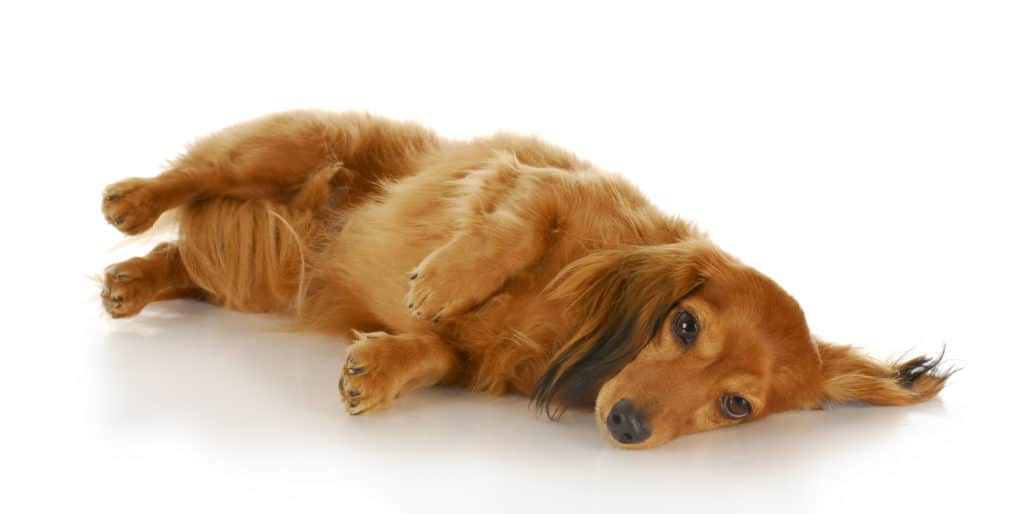
How to Care for a Dachshund with a Back Injury
Dachshunds are fascinating and adorable pets, with their vibrancy, cute little legs, and sausage-like backs. Their energy can be addictive, and when you have this dog’s company, there is never a dull moment.
Unfortunately, this oddly cute body can be both a blessing and a curse. So, what is the curse? Well, it is the elongated back that is prone to back pain and injury. Add to it the support of its tiny legs, and your Dachshund can hurt their back worse than many other dog breeds.
While dachshund back injury can be caused by an accident or old age, the most common form of back pain in Dachshunds results from a condition called Intervertebral Disc Disease (IVDD). As a dog owner, if you are wondering how to care for a dachshund with a back injury, read on to learn more about IVDD, its symptoms, and what you can do to make your lovely pet feel better.
Dachshunds and Intervertebral Disc Disease (IVDD)
IVDD, a degenerative disorder that affects mainly short-legged dogs dog breeds, is a condition in which the disks in the dog’s vertebral column degenerate, causing the jelly-like substance on the inside to herniate (come out of the disc) and harden. With the jelly-like inner filling gone, the vertebral column loses its flexibility. Thus, movement is impaired, and back pain arises.
But why are Dachshunds more prone to this disease? Well, blame the genes. Their short legs and long back make the soft center material of the disk serve as a shock absorber. The long vertebral column, thus, ages more rapidly compared to that of other dogs. Therefore, we often see a larger number of younger Dachshunds getting IVDD-related or back pain when compared to young ones of other breeds.
Signs and Symptoms of IVDD
IVDD, when severe, can completely paralyze your dog. Hence, you must catch it in its early stage, so that you can get your dog the necessary treatments. Look out for these initial symptoms.
Related Post: How to Prevent Dachshund Back Problems
- Your dog is reluctant to move and is distressed when you try to touch or cuddle it.
- When it walks, you notice limping or that something is wrong with the way it walks. Maybe it also walks slower than usual.
- Your dog will be less energetic than usual, refusing to jump, go up and down the stairs, or even stand up.
- It appears that it has difficulty standing for a long. Even if it does stand, its legs tremble.
- Its elongated back looks arched as if there is a hump.
- Your dog refuses food, refuses games, and shows a general disinclination towards any activity.
IVDD Treatment Options
Now comes the big question. Can IVDD in Dachshunds be treated? In many cases, Dachshunds, when diagnosed early, have been seen to make partial or full recoveries. The first thing, of course, is to gently carry your dog to the vet if you notice any symptoms.
Once diagnosed, based on the severity of the disease, your vet might suggest surgery or a conventional treatment plan. Here are the differences between the two.
Related Post: Understanding And Treating Arthritis In Dachshunds
Non-Surgical Approach
If the back pain from IVDD is mild, the vet is more likely to suggest a conservative treatment plan. In such a method, they treat the back pain with steroids and pain medication, while advising complete crate rest.
Now, as Dachshunds are usually vibrant animals, it is challenging to keep them locked up in a crate for days together. Initially, when the dog is in immense pain and has difficulty moving, it may easily rest in a crate. But once the agony begins to subside, it grows restless and starts to want to get out.
When this happens, you, as a dog owner, must be extremely strict and disciplined. Your Dachshund needs a long period of crate rest to be able to fully recover from IVDD-related back pain. It is best to crate-train it from a puppy age because you are likely to have to use this training later when IVDD rears its ugly head.
Surgery
Sometimes, when IVDD has reached its later stage in your Dachshund, surgery might be the only option. If your dog wakes up paralyzed one day, you must get your dog to the vet within 24 hours of noticing the severe symptoms. Any delay beyond that will considerably reduce the chances of recovery for your furry little friend.
Surgery is expensive, but where it is the only option, dilly-dallying it might make your dog disabled forever. Some Dachshunds may not recover completely even after surgery, but those cases are fewer.
Do note that post-surgery care should be at an optimum level for you to see the benefits of the procedure. Give the dog its medication on time, allow ample crate rest, and follow up with your vet regularly to speed up the recovery process.
Related Post: Senior Dog Care Tips

Physical Therapy and Rehabilitation
Even though it may be hard to digest, there are scenarios when Dachshunds do not recover from back pain related to IVDD. It is heartbreaking to see your once-healthy dog lying down quiet and dejected.
But there are still things you can do to keep your dear Dachshund happy, even amid the pain. You can opt for any form of physiotherapy, for example, massage and hydrotherapy. Also, if your dog is still able to walk a little, try going for gentle walks to keep the muscles active.
Click here to see our pick of the best ramps for dachshunds
Using a Doggy Wheelchair
When in pain, allow your Dachshund to get all the crate rest it craves, but do not underestimate the healing powers of getting out of the house. Now, if your dog is paralyzed from the pain and walking is not an option, the next best thing is to get a wheelchair made particularly for dogs.
Take your dog’s measurements into consideration when ordering a doggy wheelchair. In most cases, you may have to have it custom-made. With proper pain management and the support of the wheelchair, your pet is bound to be happy walking next to you in your front garden again.
Quality of Life Matters
As much as you may think that Dachshunds are going to jump around the house forever, the sad truth is, that IVDD is extremely common in this breed, limiting their ability to move, and in some cases, robbing them of the joy of jumping permanently.
If you are a first-time Dachshund owner, do not let that demoralize you. Instead, stay in the know-how and be prepared for the day when IVDD may strike. When it does, do your best to care for your dog and relieve it from its back pain through an appropriate treatment plan.
If all else fails, remember that your dog still has the right to live a happy and high-quality life. The pet that has been by your side now requires your unconditional love and support to look past the pain and live as comfortably as possible.
If you want to find the best pet insurance for your dachshund, click here
Conclusion
Caring for a dachshund with a back injury requires dedication and patience. By understanding the unique needs of these adorable dogs, following proper veterinary guidance, and implementing preventive measures, you can ensure your dachshund’s comfort and well-being. Remember, your care and attention play a vital role in their recovery journey.
Related post: Dachshund Back Problems and How to Avoid Them
Reference Links
- https://www.petmd.com/dog/slideshows/7-ways-treat-and-prevent-back-problems-dachshunds
- https://www.medvetforpets.com/canine-intervertebral-disk-disease-treatment/
Recent Posts
Calculate the perfect food portions for your dachshund with our specialized calculator. Get customized feeding recommendations based on size, age, and activity level to support your wiener dog's back...
Looking for the perfect gift for a proud dachshund mom? We’ve rounded up the cutest dachshund shirts that celebrate your love for wiener dogs in style. Whether you’re shopping for yourself or a...



